|
|
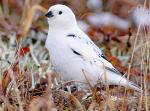
|
McKay's Bunting
|
Overview
McKay's Bunting: Large bunting, bright white body, black wing tips, black markings on back and tail. Large bill, legs, and feet are black. Said to be the whitest of all North American songbirds. Forages on ground. Swift flight, alternates raping wing beats with wings pulled to sides. |
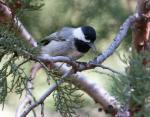
|
Mexican Chickadee
|
Overview
Mexican Chickadee: Small chickadee with gray upperparts, sides, and undertail coverts, black cap and bib, white cheeks, and white lower breast and belly. Wings and tail are gray. Legs and feet are gray-black. The only chickadee found in Mexico, and is vulnerable to diminishing habitat. |
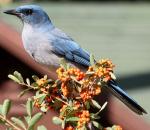
|
Mexican Jay
|
Overview
Mexican Jay: Large, crestless jay, blue-gray back, blue head, wings, rump, tail, and pale gray underparts. Bill, legs, feet are black. Feeds primarily on acorns, also eats insects, fruit, carrion and eggs and young of other birds. Slow steady bouyant wing beats. Glides between perches. |
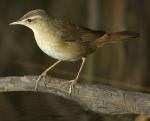
|
Middendorff's Grasshopper-Warbler
|
Overview
Middendorf's Grasshopper Warbler: Medium warbler, rust-brown upperparts, dark brown rump, white underparts with brown wash on lower breast, sides. Throat and eye brows are white. Tail is short and white-tipped. Legs and feet are orange. Alternates rapid wing beats with wings tucked to sides. |
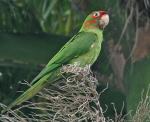
|
Mitred Parakeet
|
Overview
Mitred Parakeet: Fairly large green parakeet with red forehead grading into scattered bright red feathers on crown, face, cheek, sometimes on the bend in the wing. Dull green underparts are faintly washed olive. Hooked bill is dull yellow. Legs and feet are gray. Feeds on fruits, berries and nuts. |
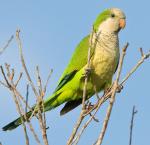
|
Monk Parakeet
|
Overview
Monk Parakeet: Medium parakeet, green overall, gray forehead, cheeks, lores, throat. Breast is gray, variably barred by dark edges on feathers. Pale pink bill. Belly; lower back, and rump are yellow-green. Wings are dull green with blue flight feathers. Tail is green above with central blue shafts. |
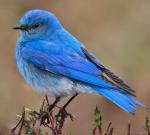
|
Mountain Bluebird
|
Overview
Mountain Bluebird: Small thrush with brilliant blue back, head, and wings. Throat and breast are paler blue, and belly and undertail coverts are white. Hovers more than other bluebirds and drops on prey from above, also catches insects in flight. Eats mostly insects in the summer. |
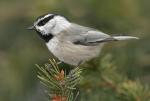
|
Mountain Chickadee
|
Overview
Mountain Chickadee: Medium chickadee, gray upperparts, black cap and bib, white cheeks and nape, and pale gray underparts. The wings and tail are gray. Bill is black, legs and feet are gray-black. It has a white eyebrow, which differentiates it from all other North American chickadees. |
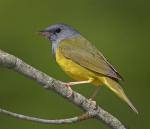
|
Mourning Warbler
|
Overview
Mourning Warbler: Medium-sized warbler with an olive-green back, wings, tail, and gray hood. The underparts are yellow and the upper breast is black. It's named for the way its dark breast and hood resemble a person in mourning. It is one of the latest spring migrants of all North American warblers. |

|
Narcissus Flycatcher
|
Overview
Narcissus Flycatcher: Small flycatcher, black head, nape, back, wings, and yellow-orange throat, upper breast, and eye brow; rump is yellow. Wings have white wing patch on inner secondary coverts; tail is long, black. Belly and undertail coverts are white. Black legs, feet. Weak fluttering flight. |
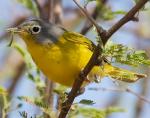
|
Nashville Warbler
|
Overview
Nashville Warbler: Small warbler, olive-green upperparts, yellow underparts, white lower belly. Small chestnut-brown cap, barely noticeable. Gray hood extends to back, eye-ring is white. Two breeding populations, a mid to northeastern one that doesn't wag its tail, and a Pacific Coast one that does. |
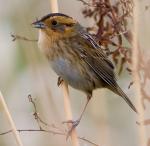
|
Nelson's Sharp-tailed Sparrow
|
Overview
Nelson's Sharp-tailed Sparrow: Small sparrow with brown streaked upperparts. Breast and sides are pale brown with pale streaks; throat, belly, and undertail coverts are white. Head has gray-brown crown and nape, orange-brown face, and gray cheeks. Tail is short and pointed. Pink-gray legs and feet. |
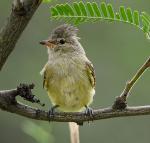
|
Northern Beardless-Tyrannulet
|
Overview
Northern Beardless-Tyrannulet: Small flycatcher with gray upperparts and breast, slight crest, pale eyebrow, indistinct eye-ring, and dull white or pale yellow belly. Wings are gray with two pale bars. The bill is small, slightly decurved, and dark with an orange base. Weak direct flight. |
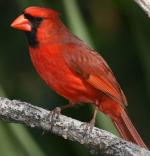
|
Northern Cardinal
|
Overview
Northern Cardinal: Large, crested finch. The male has a vivid red body. The black mask and chin contrast with heavy, red bill. The female is duller overall with red wings and tail, washed with gray, and has smaller crest. Juvenile resembles female, but is browner and has a dark bill. Forages on ground and in trees and bushes. Feeds on seeds, grains, fruits, insects and snails. Hops instead of walks on ground. Alternates rapid wing beats with wings pulled to sides. |
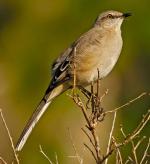
|
Northern Mockingbird
|
Overview
Northern Mockingbird: Medium-sized mockingbird with gray upperparts, paler gray underparts, and faint eyeline. Wings are gray-black with two white bars and large white patches visible when spread. The tail is long, gray, and edged with white. Legs and feet are black. Feeds on fruit and insects. |
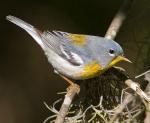
|
Northern Parula
|
Overview
Northern Parula: Small, compact warbler with blue-gray upperparts and bronze-green back patch. Throat and breast are yellow, breast band is chestnut-brown and black, belly and undertail coverts are white. White eye-ring is broken. Wings are blue-gray with two white bars. Tail is noticeably short. |
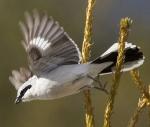
|
Northern Shrike
|
Overview
Northern Shrike: Medium shrike with gray upperparts,pale gray underparts. Mask is black with white border, bill is heavy and slightly hooked. Wings are black with white patches. Tail is long, black, and white-edged. Legs and feet are black. Flight is swift and undulating on shallow rapid wing beats. |
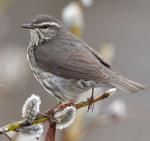
|
Northern Waterthrush
|
Overview
Northern Waterthrush: Large, ground-walking warbler with dark brown upperparts and white to pale yellow underparts with dark, heavy streaks. Eyebrows are thick and vary from pale yellow to white. It flies swiftly in a direct line for short distances. Territorial in both its winter and summer ranges. |
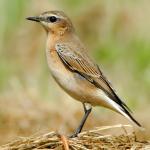
|
Northern Wheatear
|
Overview
Northern Wheatear: Small thrush (oenanthe), with gray upperparts, black wings, mask, and tail. Underparts are white, and buff-brown wash on throat. Dark gray back and nape. Very active bird, nervous and restless while foraging. Bobs tail and often makes short flights to hawk insects. |

|
Northwestern Crow
|
Overview
Northwestern Crow: Fairly small crow , black overall with dark, stout bill, iridescent violet gloss on body, and blue-black wings. Tail is fan-shaped in flight. Feeds on marine invertebrates, insects, fish, fruits, seeds, carrion, refuse, eggs of seabirds. Direct flight on steady, stiff wing beats. |

|
Nutmeg Mannikin
|
Overview
Nutmeg Mannikin: Small finch with chestnut-brown upperparts and dark-scaled white underparts. Head is richer brown and bill is heavy and dark. Forages on the ground or hangs from stems to eat seeds. Native to Southeast Asia where they have been popular as cage birds. AKA Spice Finch. |

|
Nutting's Flycatcher
|
Overview
Nutting's Flycatcher: Medium flycatcher with olive-brown upperparts, yellow belly and undertail coverts, darker olive-brown crown, brown tail and wings, and pale gray throat, breast. Feeds on insects and berries. Strong flight on rapidly beating wings. Hovers and dips to pick up prey. |
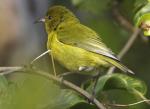
|
Oahu Amakihi
|
Overview
Oahu Amakihi: Small honeycreeper with yellow-green upperparts. Yellow throat, breast, and belly, becomes dull towards flanks and vent. Face has black lores. Gray bill is decurved. Legs and feet are gray. One of the least specialized and most adaptable Hawaiian species. |
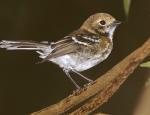
|
Oahu Elepaio
|
Overview
Oahu Elepaio: Small monarch flycatcher. Crown and back are dark brown, white underparts with buff flanks and breast. White lores, dark ear patch, rufous forehead. Black throat feathers have white tips. Wingbars, rump are white, long brown tail is white-tipped. Black bill, dark gray legs and feet. |
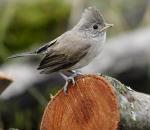
|
Oak Titmouse
|
Overview
Oak Titmouse: Medium-sized titmouse with pale, brown-tinged gray upperparts and paler face and underparts. The bill is small and black, and legs and feet are gray. Weak, fluttering flight. A recently formed species, and along with the Juniper Titmouse, was known as the Plain Titmouse until 1996. |
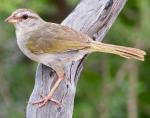
|
Olive Sparrow
|
Overview
Olive Sparrow: Medium-sized sparrow with olive-brown upperparts. Underparts are olive-gray on breast, sides, flanks and undertail coverts, and white on chin, throat and belly. Also has wide brown stripe on each side of crown and dark line through eye. Tail is rounded and dark brown. |

|
Olive Warbler
|
Overview
Olive Warbler: Medium warbler, gray back, rump, and uppertail coverts, and white belly and undertail coverts. Head, throat, nape and upper breast are orange-brown; mask is black. Wings are black, two broad white bars. Tail is notched and dark gray with white edges. Black legs, feet. |
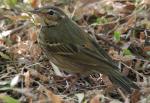
|
Olive-backed Pipit
|
Overview
Olive-backed Pipit: Medium-sized pipit with finely streaked, olive-green upperparts. White underparts, chin, belly and undertail coverts. The sides and breast are pale brown with bold dark streaks. The eyebrow is buff-orange in front and white behind eye. The legs and feet are pink |
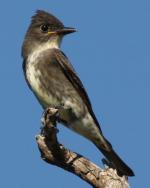
|
Olive-sided Flycatcher
|
Overview
Olive-sided Flycatcher: Large, heavy-billed flycatcher with dark olive-brown upperparts, streaked olive-brown sides, and white underparts. Head has slight crest and faint white eye-ring. Wings are dark with two pale bars. Dark tail is relatively short, broad, and slightly notched. Black legs, feet. |
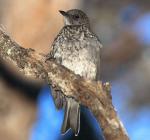
|
Omao
|
Overview
Oma'o: Most common of the Hawaiian thrushes, dark gray-brown above and pale gray below with brown edging on wings. Bill and legs are dark gray-black. Has a curious habit of fluttering drooped wings similar to a young bird begging for food. |
|
|